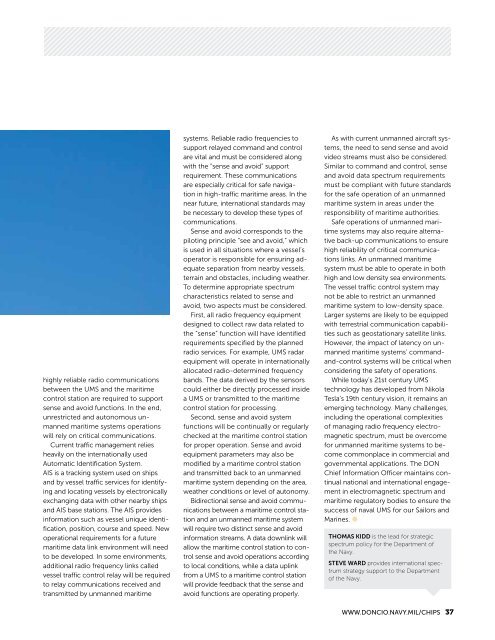Download October-December 2012 Issue (PDF) - Department of ...
Download October-December 2012 Issue (PDF) - Department of ...
Download October-December 2012 Issue (PDF) - Department of ...
You also want an ePaper? Increase the reach of your titles
YUMPU automatically turns print PDFs into web optimized ePapers that Google loves.
highly reliable radio communications<br />
between the ums and the maritime<br />
control station are required to support<br />
sense and avoid functions. In the end,<br />
unrestricted and autonomous unmanned<br />
maritime systems operations<br />
will rely on critical communications.<br />
current traffic management relies<br />
heavily on the internationally used<br />
Automatic Identification system.<br />
AIs is a tracking system used on ships<br />
and by vessel traffic services for identifying<br />
and locating vessels by electronically<br />
exchanging data with other nearby ships<br />
and AIs base stations. the AIs provides<br />
information such as vessel unique identification,<br />
position, course and speed. new<br />
operational requirements for a future<br />
maritime data link environment will need<br />
to be developed. In some environments,<br />
additional radio frequency links called<br />
vessel traffic control relay will be required<br />
to relay communications received and<br />
transmitted by unmanned maritime<br />
systems. reliable radio frequencies to<br />
support relayed command and control<br />
are vital and must be considered along<br />
with the “sense and avoid” support<br />
requirement. these communications<br />
are especially critical for safe navigation<br />
in high-traffic maritime areas. In the<br />
near future, international standards may<br />
be necessary to develop these types <strong>of</strong><br />
communications.<br />
sense and avoid corresponds to the<br />
piloting principle “see and avoid,” which<br />
is used in all situations where a vessel’s<br />
operator is responsible for ensuring adequate<br />
separation from nearby vessels,<br />
terrain and obstacles, including weather.<br />
to determine appropriate spectrum<br />
characteristics related to sense and<br />
avoid, two aspects must be considered.<br />
first, all radio frequency equipment<br />
designed to collect raw data related to<br />
the “sense” function will have identified<br />
requirements specified by the planned<br />
radio services. for example, ums radar<br />
equipment will operate in internationally<br />
allocated radio-determined frequency<br />
bands. the data derived by the sensors<br />
could either be directly processed inside<br />
a ums or transmitted to the maritime<br />
control station for processing.<br />
second, sense and avoid system<br />
functions will be continually or regularly<br />
checked at the maritime control station<br />
for proper operation. sense and avoid<br />
equipment parameters may also be<br />
modified by a maritime control station<br />
and transmitted back to an unmanned<br />
maritime system depending on the area,<br />
weather conditions or level <strong>of</strong> autonomy.<br />
bidirectional sense and avoid communications<br />
between a maritime control station<br />
and an unmanned maritime system<br />
will require two distinct sense and avoid<br />
information streams. A data downlink will<br />
allow the maritime control station to control<br />
sense and avoid operations according<br />
to local conditions, while a data uplink<br />
from a ums to a maritime control station<br />
will provide feedback that the sense and<br />
avoid functions are operating properly.<br />
As with current unmanned aircraft systems,<br />
the need to send sense and avoid<br />
video streams must also be considered.<br />
similar to command and control, sense<br />
and avoid data spectrum requirements<br />
must be compliant with future standards<br />
for the safe operation <strong>of</strong> an unmanned<br />
maritime system in areas under the<br />
responsibility <strong>of</strong> maritime authorities.<br />
safe operations <strong>of</strong> unmanned maritime<br />
systems may also require alternative<br />
back-up communications to ensure<br />
high reliability <strong>of</strong> critical communications<br />
links. An unmanned maritime<br />
system must be able to operate in both<br />
high and low density sea environments.<br />
the vessel traffic control system may<br />
not be able to restrict an unmanned<br />
maritime system to low-density space.<br />
larger systems are likely to be equipped<br />
with terrestrial communication capabilities<br />
such as geostationary satellite links.<br />
However, the impact <strong>of</strong> latency on unmanned<br />
maritime systems’ commandand-control<br />
systems will be critical when<br />
considering the safety <strong>of</strong> operations.<br />
while today’s 21st century ums<br />
technology has developed from nikola<br />
tesla’s 19th century vision, it remains an<br />
emerging technology. many challenges,<br />
including the operational complexities<br />
<strong>of</strong> managing radio frequency electromagnetic<br />
spectrum, must be overcome<br />
for unmanned maritime systems to become<br />
commonplace in commercial and<br />
governmental applications. the dOn<br />
chief Information Officer maintains continual<br />
national and international engagement<br />
in electromagnetic spectrum and<br />
maritime regulatory bodies to ensure the<br />
success <strong>of</strong> naval ums for our sailors and<br />
marines. �<br />
thomas kiDD is the lead for strategic<br />
spectrum policy for the <strong>Department</strong> <strong>of</strong><br />
the Navy.<br />
steve WarD provides international spectrum<br />
strategy support to the <strong>Department</strong><br />
<strong>of</strong> the Navy.<br />
WWW.DOnCIO.naVY.mIL/CHIPS 37

















